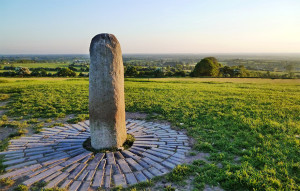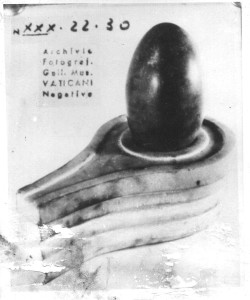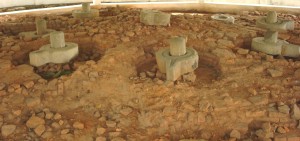Mysterious cases of Shivlings found across the world!
Shiva Lingam: Some unknown truths
A look at the curved, oval, iconic representation of Shiva Lingam placed on a globular base, which is found in the Sanctum Sanctorum (Garbhagraha) of all Shiva temples, has given rise to diverse explanations, without comprehending the scientific truths revealed by the ancient Hindu sages. The practice of worshipping Shiva Lingam as the holy symbol of Lord Shiva exists since time immemorial and crosses all boundaries. Read on to know some mind-blowing theories”¦
Shiva Lingam was worshipped all across the globe
The worship of Shiva Lingam was not confined to India and Sri Lanka only. Lingam was referred to ”˜Prayapas’ by the Romans who introduced the worship of Shiva Lingam to European countries. The statutes of Shiva Lingams were found in the archeological findings in Babylon, a city of ancient Mesopotamia. Further, the archeological findings in Harappa-Mohanjo-daro yielded numerous Shiva Lingam statutes, which disclose the existence of a highly evolved culture long before the Aryan’s immigration.
The configuration of Shiva Linga
Shiva Lingam consists of three parts. The bottom part which is four-sided remains underground, the middle part which is eight-sided remains on a pedestal. The top part, which is actually worshipped, is round. The height of the round part is one-third of its circumference. The three parts symbolize Brahma at the bottom, Vishnu in the middle and Shiva on the top. The pedestal is provided with a passage for draining away the water that is poured on the top.
Misinterpretations
The Lingam symbolizes both the creative and destructive power of Lord Shiva and great sanctity is attached to it by the devotees. This does not mean others should give a false meaning to the image of Shiva Lingam. It is unfortunate for some critics to have an imaginary invention on the image of Shiva Lingam as a male organ and viewed with obscenity, but had conveniently forgotten how a phallus could have appeared from the base.
The concept
Since Lord Shiva is described as having no form, it is ridiculous to maintain that Lingam represents a phallus. This is the reason why Swami Vivekananda described Shiva Lingam as the symbol of the Eternal Brahman, when a German Orientalist, Gusta Oppert traced it to phallicism. Swami Vivekananda cited Atharva Veda that the worship of Shiva Lingam was sung in praise of sacrificial post ”“ a description of the beginningless and endless of the Eternal Brahman and refuted it as an imaginary invention.
Kinds of Shivalinga
The Lingam is shaped like an egg and represents the ”˜Brahmanda’ or the cosmic egg. There are two types of Shiva Lingam. One is a black meteorite egg-shaped stone. It is said that such a stone is installed at Kabba in Mecca. The other one is man-made and is solidified mercury. Solidifying mercury is an ancient Vedic science. Shiva Lingam represents the totality of the Cosmos and the Cosmos, in turn, being represented as a Cosmic Egg.
Six kinds of Shivalingas
- Daiva-lingas are those installed and worshipped by the gods and other celestial beings, and thus named after them. They continue to exist in the present day and on earth, but their origin is traditionally ascribed to the gods. 2. Asura-lingas are those installed by the class of the wicked titans (known as asuras) but were pious and zealous devotees of Shiva (like Ravana); 3. Arsha-lingas were installed and worshipped by sages of yore (like Agastya). 4. Purana-lingas are those which have been celebrated as installed at the very distinct past by mythical personages. 5. Manusha-lingas are those that have been caused to be made by human patrons (rulers, chieftans, wealthy folk etc) in historical times and 6. Svayambhu-lingas are the forms which Shiva assumed to manifest himself.
Ancient Shiva Linga in Ireland
In County Meath, Ireland, on the Hill of Tara sits a mysterious stone known as the Lia Fáil (Stone of Destiny). According to The Annals of the Four Masters, an ancient document written by Franciscan Monks between 1632-1636 AD, this stone was brought to Ireland by the Tuatha Dé Danann – supernaturally gifted people. Some speculate it was they who brought the power to make bronze to Ireland. They were the main deities of pre-Christian Gaelic Ireland.
The legend
The Tuatha Dé Danann, meaning the children of the goddess Danu, are said to have ruled Ireland from 1897 B.C. to 1700 B.C. having arrived from the coast on ships. The Christian monks viewed the stone as a pagan stone idol symbolic of fertility. This stone was so important that it was used for the coronation of all Irish Kings up until 500 AD. The goddess Danu in European tradition was a river goddess. In some Irish texts her father is said to be Dagda (the good god), a father figure in Irish tradition.
The Vedic connection
The Vedic tradition also has a goddess Danu, the daughter of Daksha, wife of Kasyapa Muni, who was a goddess of the rivers. The word Danu in Sanskrit means ‘flowing water’. As the daughter of Daksha, her sister Sati was married to Lord Shiva. To practitioners of Vedic tradition the Lia Fáil matches very closely to the Shiva Linga. Eventually the Tuatha Dé Danann were defeated in battle. According to legend, they were allowed to stay in Ireland only under the ground as the ‘Aes sidhe’ – people of the fairy mounds.
Ancient Shiva Lingas Found throughout Vietnam
Vietnam was the home to a vibrant Vedic civilization. Many spectacular temples and sculptures still remain to this day .Throughout Vietnam many ancient Shiva Lingas have been found, dating back thousands of years. This is further proof of the vast extent of Vedic culture throughout the world.
Etruscan Museum at the Vatican
This piece is at present on view in the Etruscan Museum at the Vatican in Rome. Encyclopedia Britannica mentions under the headings “Etruria” and “Etruscan” that between the 2nd and 7th centuries BC, northern Italy was known as Etruria. During excavations many such “meteoric stones mounted on carved pedestals” are discovered in Italy. Obviously, therefore, this one was dug up from the Vatican itself. Many more must be lying buried in the Vatican’s massive walls and numerous cellars.
5,000 year old Shivalinga found at Harappa
In 1940, archaeologist M.S. Vats discovered three Shiva Lingas at Harappa, dating more than 5,000 years old. This rare archival photo shows that ancient Shiva Linga as it was being excavated from the Harappa site.
Shivalinga in Africa
There is Shiva in Kailasha and there is Shiva in Kashi and now in Africa too. The discovery of a Shiva idol in South Africa is the proof that 6000 years ago Africans used to worship him. Archeologists have found 6000 year old Shivalinga in a cave named Sudwara in South Africa and it is made of hard granite stone. The archeologists are amazed that how the Shivalinga survived there for so long.
Statue of Lord Shiva’s sacred bull found in Indonesia
Archaeologists have found a statue of Nandi, the sacred bull that carried the Hindu god Shiva, among the ruins of what is believed to be an ancient temple at an excavation site in Yogyakarta in Indonesia. The head of the excavation team from the Yogyakarta Antiquities and Relics Conservation Agency said, “The statue is exquisite. The sculpture is carved differently from other statues of Nandi. This one is not depicted as fat.”
Other findings
Previous discoveries at the site, which is located on the Indonesian Islamic University campus, include a statue of Ganesha, Shiva’s divine son; a linga , the symbol of worship for Shiva; and a yoni , a Hindu symbol for divine passage or birth. The head of the excavation team said that archeologists were working under the assumption that the pillars had not been destroyed by a volcanic mudflow hundreds of years ago, but had instead been removed by people.
Lord Shiva and Roman God Neptune
Notice the trident on this statue of Neptune, typical of Shiva. The trident was always an emblem of Lord Shiva. Neptune is also seen here standing on an entity in which case Shiva is also seen at times standing on the being of ignorance, illusion, or maya, showing that he is not affected by the power of the illusory energy. Also here, Neptune’s hand is raised in a calming gesture, and when Shiva’s hand is raised it signifies abhaya or giving blessings and represents sthiti, or preservation and protection.
Wandering impressions of Vedic culture
Thus, anyone familiar with Vedic culture will realize that he is styled in a similar way to Lord Shiva. This shows how the impressions of Vedic culture and its gods came from India, though styles and names may have changed as it traveled west.
– Pallavi Thakur, Times of India
Short URL: https://indiandownunder.com.au/?p=5548






